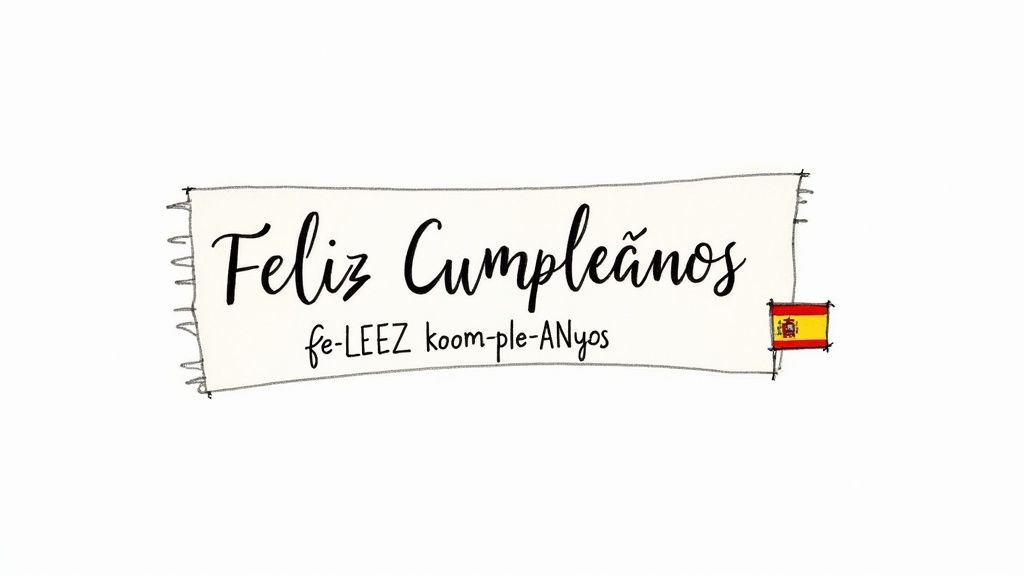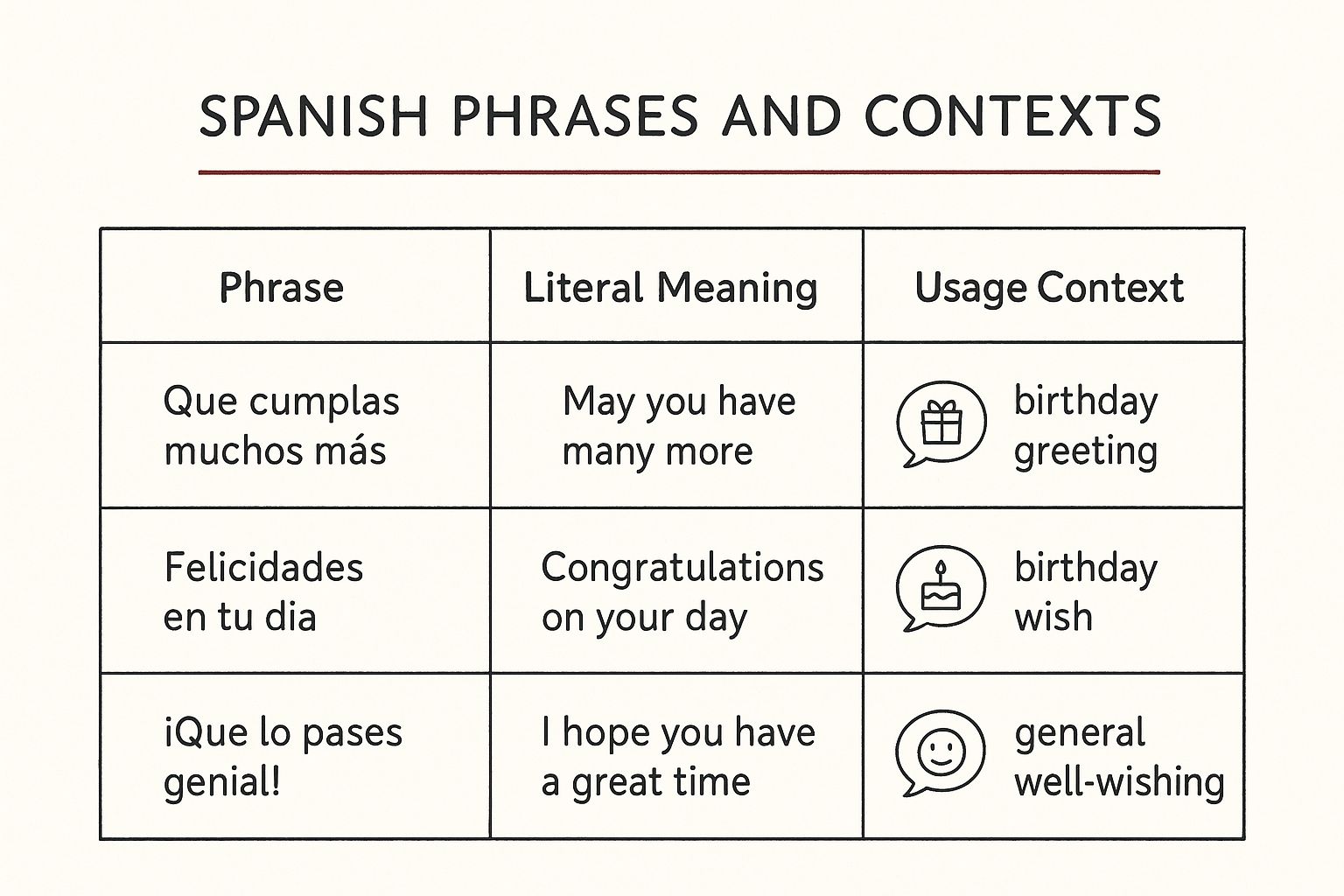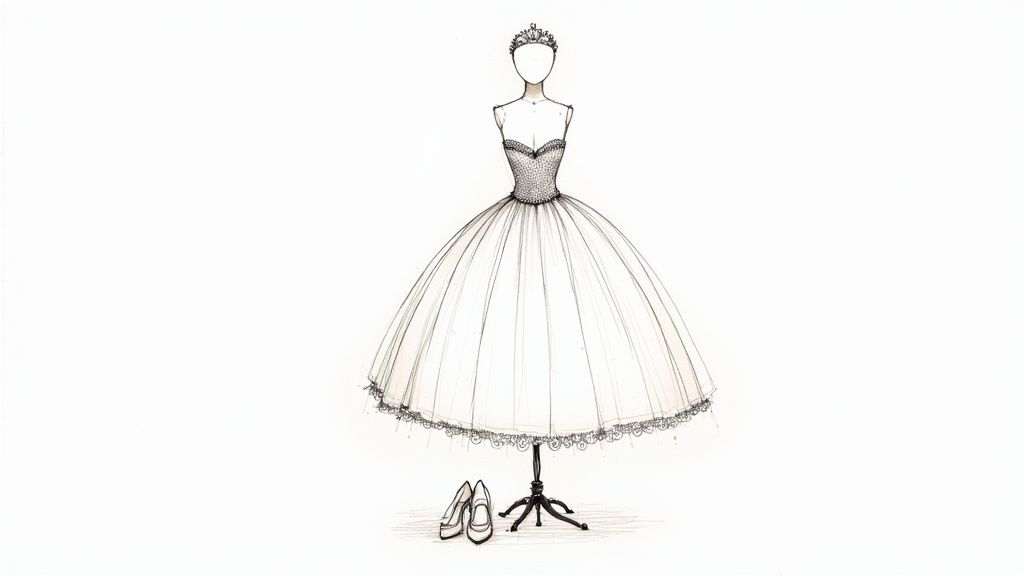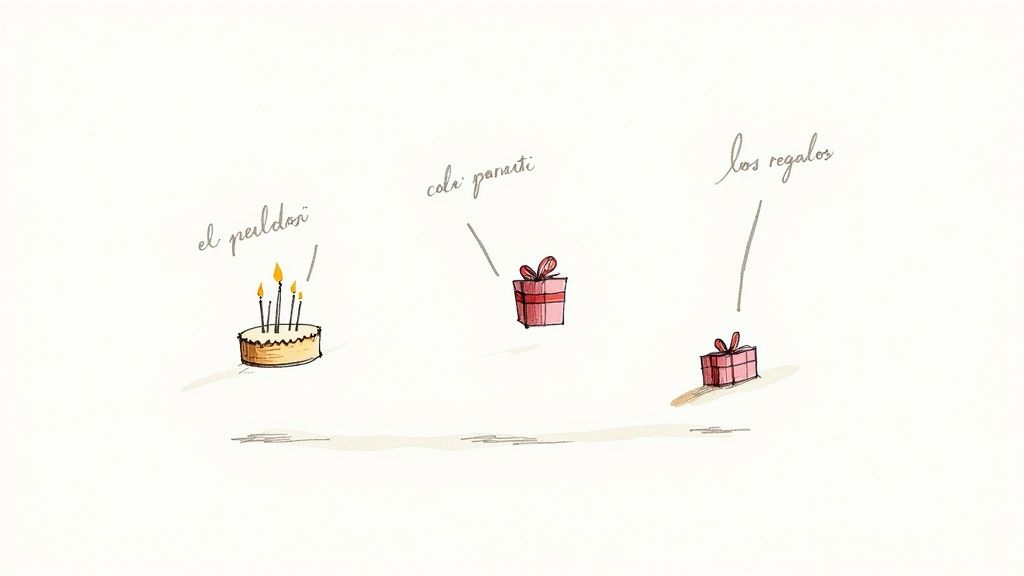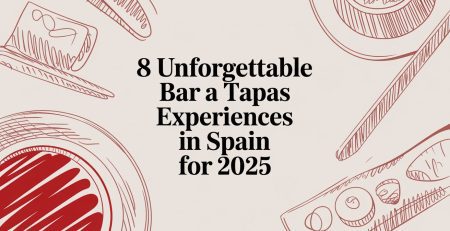Saying Happy Birthday in Spanish the Right Way
If you're looking to wish someone a happy birthday in Spanish, there's one phrase that will work absolutely everywhere, from Madrid to Mexico City: ¡Feliz Cumpleaños! It's the go-to, universally understood greeting for celebrating someone's special day.
Think of it as the direct equivalent of "Happy Birthday!" in English. It's friendly, correct, and you can't go wrong with it.
What Does Feliz Cumpleaños Actually Mean?
To really get this phrase to stick in your mind, it helps to break it down. "Feliz" is the easy part—it simply means "happy."
The second word, "cumpleaños," is where it gets interesting. It’s actually a mash-up of two Spanish words: cumplir, which means "to complete" or "to fulfil," and años, which means "years."
So, when you say ¡Feliz Cumpleaños!, what you're really saying is "happy completion of years." It's a beautiful sentiment that adds a bit more depth than just a simple "happy birthday," isn't it? Knowing this little detail makes the phrase so much easier to remember.
How to Pronounce It Like You Mean It
Sounding natural is all about getting the pronunciation right. For native English speakers, it’s not as tricky as it might seem. Let’s walk through it.
- Feliz: Pronounce this as feh-LEES. The 'z' at the end sounds like a soft 's' in Latin America. In most of Spain, it has more of a 'th' sound, but sticking with the 's' sound is perfectly fine anywhere.
- Cumpleaños: This one is koom-pleh-AHN-yohs. The key here is the 'ñ' sound, which is unique to Spanish. Just think of the 'ny' sound in the middle of the word "canyon" or "onion"—that's the sound you're aiming for.
Try saying it aloud a few times: "Feh-LEES Koom-pleh-AHN-yohs." It might feel a little awkward at first, but practice makes perfect.
To get you started on the right foot, here’s a quick reference table with the most common birthday wishes you’ll encounter.
Quick Guide to Spanish Birthday Greetings
This table covers the most essential phrases, their translations, and a simple guide to help you nail the pronunciation.
| Spanish Phrase | English Translation | Pronunciation Tip |
|---|---|---|
| ¡Feliz Cumpleaños! | Happy Birthday! | feh-LEES koom-pleh-AHN-yohs |
| ¡Felicidades! | Congratulations! | feh-lee-see-DAH-dehs |
| ¡Que cumplas muchos más! | And many more! | keh KOOM-plahs MOO-chohs mahs |
Keep this little guide handy, and you'll be ready for the next birthday celebration that comes your way
Sound Like a Native with These Birthday Phrases
While ¡Feliz Cumpleaños! is your go-to phrase, think of it as the basic, all-purpose key. To really open the door to sounding more natural and heartfelt, you’ll want a few more keys on your ring. It’s the difference between a polite nod and a warm, genuine hug—both work, but one feels a lot more special.
A fantastic and incredibly common alternative is simply ¡Felicidades! (Congratulations!). Now, in English, we tend to save "congratulations" for big achievements like a graduation or a new job. But in the Spanish-speaking world, it's a perfectly warm and joyful way to say happy birthday. It fits in anywhere, from a quick text message to a handwritten card.
Going Beyond a Simple Greeting
Want to add a little more heart to your message? It's easy. Just tack on a phrase that wishes the person well for the future. Think of it as the personal P.S. you'd add to a birthday card.
One of the most popular is ¡Que cumplas muchos más! Literally, this means "May you complete many more," but it’s the Spanish equivalent of "And many more to come!" It’s a beautiful, simple way to wish someone a long and happy life.
Another great option is ¡Felicidades en tu día! which translates to "Congratulations on your day!" This one really puts the focus on the birthday person, making them feel like the centre of attention on their special occasion.
Weaving Wishes into Conversation
Birthdays in Spanish-speaking cultures are all about celebration, and that almost always includes a song! You’ll often hear the classic birthday song followed by a fun, hopeful wish like, "Que los sigas cumpliendo hasta el año tres mil" (May you keep having birthdays until the year 3000).
Getting these little phrases right is a huge step toward sounding more fluent. If you're working on your pronunciation, you can even find tools that let you change your text-to-speech voice to Spanish to hear how a native would say it.
And once you’ve mastered birthday wishes, why not brush up on other daily greetings? Our guide on how to ask 'how are you?' in Spanish is a great place to start.
Celebrating Birthdays Across the Spanish-Speaking World
Knowing how to say "happy birthday in Spanish" with a cheerful ¡Feliz Cumpleaños! is a fantastic start. But if you really want to connect with someone, understanding the culture behind the celebration is what truly matters. The Spanish language may be a common thread across more than 20 countries, but the birthday traditions themselves are wonderfully diverse.
Think of it like a festival. Everyone is there to celebrate the same thing, but the music, food, and specific customs can change dramatically from one place to the next. It’s this local flavour that makes each birthday feel so unique.
A Glimpse into Regional Traditions
Let's start in Mexico, where birthdays are an explosion of colour and sound. It's not uncommon for the celebration to kick off at dawn with a heartfelt performance of "Las Mañanitas," the traditional birthday song. The rest of the day is a whirlwind of family, delicious food, and the iconic piñata, which is way more than just a game—it’s a beloved centrepiece that brings everyone together.
Now, let's jump across the Atlantic to Spain. Here, many people get to celebrate twice! They have their actual birthday (cumpleaños) and their saint's day (día del santo). This tradition comes from the country's deep Catholic roots, where someone named after a particular saint celebrates that saint's feast day as if it were their own.
Planning a celebration yourself? You might find some unforgettable birthday party entertainment ideas that can add a fun twist, no matter where you are in the world.
The real takeaway here is that a birthday greeting means so much more when it's backed by genuine curiosity about the person's culture. It’s not just about saying the right words; it's about showing you care.
To give you a better idea of this diversity, let's look at a few examples side-by-side.
Birthday Traditions Across Spanish-Speaking Countries
| Country | Unique Song/Greeting | Key Tradition |
|---|---|---|
| Mexico | "Las Mañanitas" is the essential birthday song. | Breaking a piñata filled with sweets and toys is a must-do. |
| Spain | No specific song, but ¡Feliz Cumpleaños! is standard. | Celebrating one's "santo" or saint's day in addition to their birthday. |
| Argentina | "Que los cumplas feliz" is the common birthday tune. | Lightly pulling the earlobes of the birthday person for each year of their life. |
| Colombia | "Feliz Cumpleaños a Ti" (a version of the English song). | The "torta" (cake) is often a central part of a big family gathering. |
| Venezuela | "Ay, qué noche tan preciosa" is often sung. | Having a "cotillón," a bag of party favours and treats for guests. |
As you can see, while the sentiment is the same, the execution is beautifully different.
This infographic gives you a quick visual guide to some other popular phrases you can use.
Adding a little something extra, like '¡Que cumplas muchos más!' (May you have many more!), is a simple way to add warmth to your wish. Knowing these small variations helps you sound less like a textbook and more like a friend, turning a simple greeting into a truly memorable gesture.
Diving Into the Quinceañera Celebration
In many Spanish-speaking cultures, certain birthdays carry a weight far beyond just another year. The quinceañera, which marks a girl's 15th birthday, is perhaps one of the most significant cultural milestones you'll encounter in Latin America.
This isn't just an extravagant party. The quinceañera is a deeply symbolic event that celebrates a young woman's journey from childhood into adulthood, packed with traditions that have been cherished for generations.
What Makes a Quinceañera So Special?
The celebration usually kicks off with a religious service, the Misa de Acción de Gracias (a Thanksgiving Mass). Here, the birthday girl gives thanks for her life so far and seeks a blessing for the path ahead, underscoring the central role of faith and family.
After the mass comes the fiesta (the party), and this is often a grand affair, sometimes on the scale of a wedding. It's during the fiesta that some of the most memorable traditions unfold.
- The Formal Waltz: The quinceañera (the birthday girl herself) takes to the dance floor for a choreographed waltz with her father and her court of honour, made up of her damas (maids of honour) and chambelanes (chamberlains).
- Changing of the Shoes: In a really touching ceremony, her father will often swap her flat shoes for her first pair of high heels, symbolising her first steps into womanhood.
- The Last Doll: She might also be given a "last doll," a poignant gift that represents leaving behind the toys of her childhood as she embraces new responsibilities.
A quinceañera is so much more than a personal party. It's a community-wide event that strengthens family ties and honours a beautiful, time-honoured transition into a new chapter of life.
This tradition is so beloved that it continues to be a cornerstone for Hispanic communities all over the world. In the United States, it's thought that over 400,000 Hispanic girls celebrate their quinceañera every single year, often with incredible planning and significant investment from the whole family. If you're curious, you can learn more about this vibrant tradition and its history.
How to Write the Perfect Spanish Birthday Message
Taking your birthday wishes from spoken words to a written message is where you can really add a personal touch. Whether it's for a card, a quick text, or a social media post, the key to a great Spanish birthday message is to match your tone to your relationship with the person.
The simplest way to start is by combining a standard greeting with a warm wish. It’s like a simple recipe: start with ¡Feliz Cumpleaños! and then add a second ingredient to make it special. This gives your message a complete, heartfelt feel without being overly complicated.
For example, you can easily pair the classic greeting with a simple, forward-looking wish to create something that feels both familiar and thoughtful.
A great starting point is to combine two simple phrases. For example: “¡Feliz Cumpleaños! Te deseo todo lo mejor en tu día.” This translates to “Happy Birthday! I wish you all the best on your day.”
Finding the Right Words for Any Occasion
The great thing about writing a happy birthday in Spanish message is how flexible it is. You can easily tweak the language to sound casual, formal, or romantic, all depending on who you're writing to.
Here are a few ideas you can adapt for different people in your life:
- For a close friend: “¡Feliz cumple, amigo/a! Espero que tengas un día increíble y que todos tus deseos se hagan realidad. ¡A celebrar!” (Happy b-day, friend! I hope you have an incredible day and that all your wishes come true. Let's celebrate!)
- For a family member: “Querido/a [Name], ¡muy feliz cumpleaños! Te mando un abrazo gigante y mis mejores deseos hoy y siempre.” (Dear [Name], a very happy birthday! Sending you a giant hug and my best wishes today and always.)
- For a more formal or professional setting: “Estimado/a [Name], le deseo un muy feliz cumpleaños y un año lleno de éxitos. Saludos cordiales.” (Esteemed [Name], I wish you a very happy birthday and a year full of success. Kind regards.)
How to Sign Off with Warmth
How you end your message is just as important as how you start it. A good sign-off leaves a lasting impression and reinforces the warmth of your greeting. So instead of just ending with your name, try adding an authentic Spanish closing.
Think about using one of these heartfelt options:
- Con mucho cariño (With much affection)
- Un fuerte abrazo (A big hug)
- Mis mejores deseos (My best wishes)
Picking the right closing adds that final, sincere touch, turning a simple birthday wish into something genuinely meaningful.
Alright, let's move beyond just the main greeting. To really feel like you're part of the fun at a birthday party in Barcelona or Bogotá, you'll want a few more words up your sleeve. Knowing these will help you navigate the celebration with confidence and focus on what really matters: having a great time.
First things first, the star of the show: the cake. You'll hear it called el pastel in some places, like Mexico, and la torta in others, like Argentina. Sitting on top are las velas (the candles), ready for the big moment when the birthday person makes un deseo (a wish) and blows them out.
Key Party Elements
Of course, a party is more than just cake. Look around, and you'll see las decoraciones (the decorations) and plenty of los regalos (the gifts). When you hand yours over, a simple "¡Un regalo para ti!" (A gift for you!) is perfect.
Here are a few other words you'll definitely hear:
- La fiesta: The party
- La invitación: The invitation
- Los globos: The balloons
- La música: The music
- Los invitados: The guests
Actions and Celebrations
The whole point is to celebrar (celebrate), right? This involves a lot of key activities, like when everyone gathers to cantar (sing) the birthday song, and later, when the music gets going, to bailar (dance).
Picking up this vocabulary isn't just about understanding what's going on. It’s your ticket to actually participating. You can compliment the beautiful cake or ask where to put your gift, instantly shifting from a quiet observer to an active part of the celebration.
Common Questions About Spanish Birthday Wishes
Now that you've got the basics down, you might still have a few lingering questions. That's completely normal. Let’s walk through some of the common things people wonder about so you can feel totally comfortable the next time a birthday pops up.
A big one I often hear is: will ¡Feliz Cumpleaños! work everywhere? The answer is a resounding yes. Whether you're in Madrid or Mexico City, it’s the standard, universally understood way to say happy birthday. It's your go-to phrase, and you can't go wrong with it.
Choosing Between Phrases
So, what about ¡Felicidades!? When does that come into play? This is a great question. While Feliz Cumpleaños is specifically for birthdays, Felicidades is more of a general "Congratulations." It's a warm, perfectly acceptable alternative for a birthday, but you can also use it for achievements, anniversaries, or any other happy occasion.
Think of it this way: ¡Feliz Cumpleaños! is a direct translation of "Happy Birthday," while ¡Felicidades! is more like saying, "Best wishes on your special day!"
And what about formality? This is key. If you're wishing your boss or an older relative a happy birthday, you'll want to be more respectful. Something like “Le deseo un muy feliz cumpleaños” (I wish you a very happy birthday) is a solid choice. With close friends and family, feel free to keep it casual with a quick “¡Feliz cumple!”
Ready to move from birthday wishes to fluent conversations? At Spanish Council Singapore, our native teachers offer engaging lessons for all ages. Enrol in a Spanish class today!


